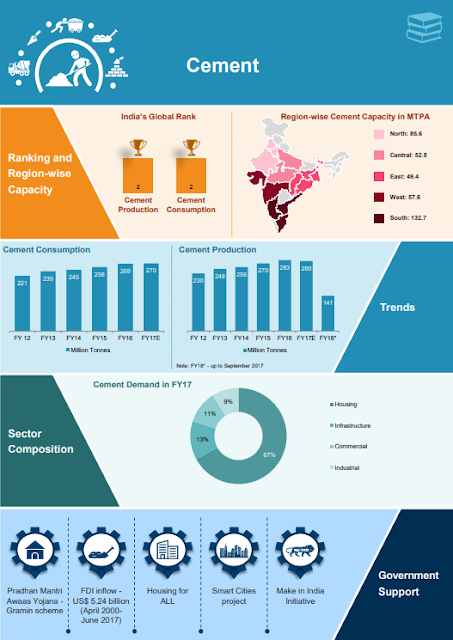India is the second largest producer of cement in the world
India is the second largest producer of cement in the world. No wonder, India's cement industry is a vital part of its economy, providing employment to more than a million people, directly or indirectly. Ever since it was deregulated in 1982, the Indian cement industry has attracted huge investments, both from Indian as well as foreign investors.
India has a lot of potential for development in the infrastructure and construction sector and the cement sector is expected to largely benefit from it. Some of the recent major initiatives such as development of 98 smart cities are expected to provide a major boost to the sector.
Expecting such developments in the country and aided by suitable government foreign policies, several foreign players such as Lafarge-Holcim, Heidelberg Cement, and Vicat have invested in the country in the recent past. A significant factor which aids the growth of this sector is the ready availability of the raw materials for making cement, such as limestone and coal.
Market Size
The housing sector is the biggest demand driver of cement, accounting for about 67 per cent of the total consumption in India. The other major consumers of cement include infrastructure at 13 per cent, commercial construction at 11 per cent and industrial construction at 9 per cent.
India’s total cement production capacity is nearly 425 million tonnes, as of September 2017. The growth of cement industry is expected to be 6-7 per cent in 2017 because of the government’s focus on infrastructural development. The industry is currently producing 280 MT for meetings its domestic demand and 5 MT for exports requirement. The country's per capita consumption stands at around 225 kg.
The Indian cement industry is dominated by a few companies. The top 20 cement companies account for almost 70 per cent of the total cement production of the country. A total of 210 large cement plants account for a cumulative installed capacity of over 350 million tonnes, with 350 small plants accounting for the rest. Of these 210 large cement plants, 77 are located in the states of Andhra Pradesh, Rajasthan and Tamil Nadu.
Investments
On the back of growing demand, due to increased construction and infrastructural activities, the cement sector in India has seen many investments and developments in recent times.
According to data released by the Department of Industrial Policy and Promotion (DIPP), cement and gypsum products attracted Foreign Direct Investment (FDI) worth US$ 5.25 billion between April 2000 and December 2017.
Some of the major investments in Indian cement industry are as follows:
- Ultratech Cement has purchased a 98.47 per cent stake in Binani Cements for Rs 7,266 crore (US$ 1.12 billion). The deal will help Ultratech achieve greater capacity and markets its product in north-India.
- JK Cement is planning to invest Rs 1,500 crore (US$ 231.7 million) over the next 3 to 4 years to increase its production capacity at its Mangrol plant from 10.5 MTPA to 14 MTPA.
Government Initiatives
In order to help the private sector companies thrive in the industry, the government has been approving their investment schemes. Some such initiatives by the government in the recent past are as follows:
The State Government of Chattisgarh has auctioned one block of Limestone (Kesla II) in Raipur District having estimated reserves of 215 million tonnes valued at Rs 10,367 crore (US$ 1.61 billion), and would earn a cumulative revenue of Rs 11,894 crore (US$ 1.85 billion) to State Government over the lease period.
In Budget 2018-19, Government of India announced setting up of an Affordable Housing Fund of Rs 25,000 crore (US$ 3.86 billion) under the National Housing Bank (NHB) which will be utilised for easing credit to homebuyers. The move is expected to boost the demand of cement from the housing segment.
Road Ahead
The eastern states of India are likely to be the newer and virgin markets for cement companies and could contribute to their bottom line in future. In the next 10 years, India could become the main exporter of clinker and gray cement to the Middle East, Africa, and other developing nations of the world. Cement plants near the ports, for instance the plants in Gujarat and Visakhapatnam, will have an added advantage for exports and will logistically be well armed to face stiff competition from cement plants in the interior of the country.
Due to the increasing demand in various sectors such as housing, commercial construction and industrial construction, cement industry is expected to reach 550-600 Million Tonnes Per Annum (MTPA) by the year 2025.
A large number of foreign players are also expected to enter the cement sector, owing to the profit margins and steady demand. In future, domestic cement companies could go for global listings either through the FCCB route or the GDR route.
With help from the government in terms of friendlier laws, lower taxation, and increased infrastructure spending, the sector will grow and take India’s economy forward along with it.
Exchange Rate Used: INR 1 = US$ 0.015 as of March 01, 2018.
References: Media Reports, Press releases, Union Budget 2018-19, Edelweiss Securities Ltd.
Disclaimer: This information has been collected through secondary research and IBEF is not responsible for any errors in the same.

Comments
Post a Comment